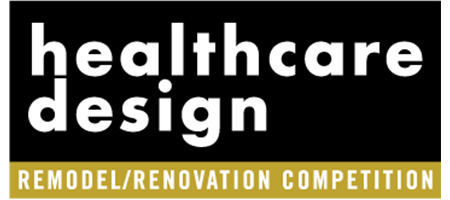City of Hope Comprehensive Cancer Center, Hope Plaza, Duarte, California: 2025 Design Showcase Award of Merit
Opened in July 2024, the 352,000-square-foot Hope Plaza serves as the new front door for City of Hope patients, combining multiple existing services into a state-of-the-art outpatient cancer center designed to enhance patient experience.
The project was submitted to the Showcase by EwingCole (Irvine, Calif.), the associate architect, planning, and interior design firm on the project, and CO Architects (Los Angeles), which served as design architect, executive architect, and environmental graphics designer.
Designed to minimize walking distances and improve efficiency and experience for both patients and staff, the facility includes cutting-edge technology to enhance care coordination, flexible infrastructure to ensure future adaptability, and infusion bays designed to support patient autonomy, with adjustable lighting and temperature controls.
Biophilic design principles also are central to the architecture, fostering a soothing atmosphere with abundant natural light, serene views of the San Gabriel Mountains, and landscaped gardens.
The thoughtful approach not only enhances daily operations but also redefines the cancer care experience. Here, Mary Frazier, principal at EwingCole, and Gina Chang, principal at CO Architects, share insights on some of the project’s planning and design strategies.
Healthcare Design: What overall goals and principles were established to guide this project?
Mary Frazier: At the outset of the Hope Plaza project, City of Hope established a set of guiding goals that would shape every aspect of the building’s design, function, and experience.
Central to the vision was a commitment to delivering patient- and family-centric care, ensuring that every decision reflected the needs, preferences, and dignity of those undergoing cancer treatment. The facility was conceived as a place of calm, healing, and peace, designed to reduce the stress and emotional toll of care while offering convenience and clarity throughout the patient journey.
A key priority was the elimination of non-value-added activities and space. This meant streamlining workflows, right-sizing program areas, and consolidating services to allow patients to complete labs, imaging, consultations, and treatment within a single location.
The integration of technology played a vital role, enabling video-enabled consults, virtual family engagement, and seamless communication between providers. At the same time, standardization across clinical modules and support spaces promoted operational efficiency, flexibility, and a consistent experience for both staff and patients.
The care model embraced an evidence-based, team-based approach, physically bringing together multidisciplinary teams and services to support coordinated, holistic care.
This collaborative environment was designed not only to improve clinical outcomes, but also to reflect City of Hope’s leadership in translational medicine, creating direct links between research, innovation, and bedside care. The facility would be adaptable by design, with flexible infrastructure that could respond to new therapies, technologies, and models of care.
Finally, City of Hope set clear benchmarks for success: The project needed to be delivered on time and on budget, while achieving the highest possible value-not just in terms of cost-effectiveness, but in its long-term impact on patient lives, staff well-being, and the advancement of cancer care.
Gina Chang: The overall goal was to create a welcoming new front door for City of Hope patients and to consolidate multiple existing services into one new building. Design inspiration comes from the site’s context, specifically the San Gabriel Mountains and the natural flow of water that descends to City of Hope’s foothills location. The CO Architects/Ewing Cole design concept envisions Hope Plaza as a boulder in an urban river wash. This gesture extends into the building, with a transparent ground-floor plane representing water flow from the mountains into the entry.
The largest building on City of Hope’s suburban Los Angeles campus, Hope Plaza activates the northeast corner of the property. The new Hope Drive leads to the patient drop-off area and into the award-winning parking garage. Cobblestone riverbeds and wooden bridges connect the Ted Schwartz Hope and Healing Park to the new outpatient center.
Additionally, the purposeful design centralizes services that were previously spread among four buildings, easing comprehensive care in an efficient layout that minimizes walking for patients. The design team imbued moments of joy throughout the building, including views of nature, inspirational art, and whimsical yet sophisticated finishes.
HCD: How does the design focus on giving some control back to patients during their treatment?
Frazier: At its core, the building is patient- and family-centric, designed to empower individuals through choice, comfort, and clarity. Every aspect of the experience-from intuitive wayfinding to personalized infusion bays-was shaped through patient and caregiver input. The result is a facility that not only delivers exceptional clinical care but also restores a sense of control and dignity to people navigating the uncertainty of cancer.
The commitment to calmness, healing, peace, and convenience is immediately evident in the building’s choreography. Visitors move from structured parking into a serene park before entering the facility, offering a moment of reflection and emotional transition. Inside, the use of natural light, mountain views, biophilic materials, and views to gardens and water features reinforces a sense of well-being and reduces stress. At every step, the design supports both the emotional and physical needs of patients and families.
By consolidating services, patients can complete labs, imaging, consultations, and treatment in a single visit, reducing the burden of multiple appointments and long travel distances across campus. Clinical zones are compact and arranged around a centralized vertical core, eliminating long hallways and redundant circulation. This efficient layout reflects a deliberate effort to ensure that patient wayfinding is not only short, but clear.
The integration of technology plays a critical role in patient empowerment and care coordination. Consult rooms are equipped for video conferencing to involve remote family members, while digital tools support streamlined scheduling, patient education, and real-time clinical collaboration.
HCD: Talk about how the project maximizes access to daylight and how that contributes to the overall healing environment?
Chang: The design team prioritized the benefits of natural light on patient and staff well-being by strategically orienting the building. An all-glass northern façade provides scenic views of the San Gabriel Mountains, emphasizing the relationship between the building and its surrounding environment.
The building’s east and west façades are clad in chevron-shaped metal panels that have perforated window shades, providing dappled light and protection from glare. The south façade features above-window shades, which provide views while lowering the solar heat gain.
On the clinic floors, where exam visits are short and require privacy, staff work rooms are located around the perimeter spaces, giving the healthcare providers access to natural daylight. On the infusion floors, the opposite is true. Each perimeter infusion bay provides daylight and views for long patient treatments.
Daylight integration underscores the importance of natural light in healthcare facilities. It improves staff attentiveness, regulates circadian rhythms, and is proven to foster successful patient outcomes.
HCD: How does the design optimize travel distances for patients?
Frazier: To optimize travel distances for patients at City of Hope’s Hope Plaza, the planning team applied data-driven methodologies during early design phases. Specifically, discrete event simulation modeling was used to evaluate and refine multiple conceptual layouts for the exam floors. The goal was to identify a configuration that would minimize patient walking distances during typical daily operations.
Three layout options were developed and tested during Schematic Design. Option One featured perimeter waiting and elevator cores, with dual-sided exam rooms and a separate patient corridor. Option Two maintained perimeter circulation but introduced team-based workstations along a shared corridor. Option Three, the selected scheme, centralized the elevators and waiting area while placing staff workstations along the building perimeter, with a separate off-stage corridor for staff circulation.
Simulation modeling revealed that this centralized configuration offered the most efficient flow for patients. It resulted in an average walking distance reduction of 200 steps per patient, which translates to a 14 percent decrease in walking distance and a 1- to 2-minute reduction in in-transit time.
These improvements support a more comfortable, less fatiguing experience for patients—many of whom are dealing with limited mobility or treatment-related fatigue—while also improving throughput and operational efficiency across the exam platform.
HCD: What are some key features of the site landscape and how do they support the project’s goals to foster connection and personalization?
Chang: The Ted Schwartz Hope and Healing Park creates a luxurious front yard for Hope Plaza and provides a range of experiences between the parking garage and the building. City of Hope’s iconic entry fountain is referenced with a new waterwall fountain and substantial art installations, while the historic original fountain was relocated to one of the peaceful courtyards within the park.
A meandering circulation, inspired by the nearby San Gabriel River Wash, leads to several healing and meditation gardens. The park provides access to nature and creates spaces for reflection, respite, and tranquility, aligning with City of Hope’s vision for the project.
The parking garage serves as a backdrop for the park. Its kinetic façades face patient views and integrate more than 19,000 colorful aluminum tags, which move in the wind.
The concept was inspired by City of Hope’s “healing tree” tradition, where patients and families write inspirational messages on colorful ribbons that are then tied around tree branches on campus. The parking-garage façade is an example of the designers’ purposeful efforts to add moments of wonder and joy to the project.
HCD: Jurors appreciated the biophilic elements, including gardens, art sculptures, and shaded pavilions. How did you integrate these elements within the building architecture?
Chang: Sculptures from City of Hope’s extensive art collection dot the garden, augmented with shade structures designed by GT2P. Artist Elena Manfredi’s tile mural on the building provides additional inspiration for patients, staff, and guests.
The new waterwall fountain provides sounds of nature to both the entry plaza as well as the dining plaza beyond.
HCD: What’s a lesson about designing for patient-centeredness that readers can learn from this project?
Frazier: One of the most impactful design strategies is the infusion bay, which allows them to retreat into a quiet, personalized environment during what can be lengthy and emotionally challenging sessions. These private spaces support rest, reduce overstimulation, and create a refuge where patients feel secure and respected.
Within each infusion bay, patients are empowered to customize their physical environment. Adjustable lighting allows them to tailor brightness based on comfort, and climate controls support personal temperature preferences. The infusion bays also include thoughtful accommodation for caregivers, with comfortable seating provided for a companion.
Proximity to supportive services is another key element in giving patients more control over their care. Infusion areas are located near resources such as nutrition counseling, behavioral health, and financial assistance. Hope Plaza also includes dedicated infusion bays for patients participating in clinical trials, seamlessly integrated into the overall care environment. This ensures that those receiving advanced or experimental therapies feel included and supported, rather than isolated.
Finally, the overall design of the facility supports streamlined care delivery, allowing patients to complete labs, imaging, consultations, and infusions-often within a single visit.
Taken together, these design features empower patients to participate more fully in their care, offering both practical convenience and emotional reassurance. The infusion experience at Hope Plaza demonstrates how a patient-centered approach to design can restore agency and promote healing at every step of the cancer journey.
For more coverage of Healthcare Design’s 2025 Design Showcase, go here.
Anne DiNardo is editor-in-chief of Healthcare Design and can be reached at [email protected].












